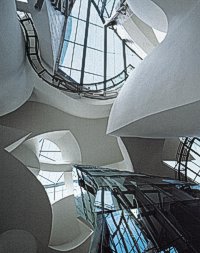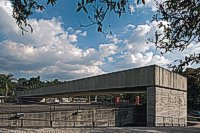Paulo Mendes da Rocha e Frank O. Gehry: 80 anni. Su "Casabella" n. 776 in edicola il 6 aprile 2009
Nell'età dei patriarchi
di Francesco Dal Co

"Lo storico d'oggi sa benissimo che egli non ha il diritto di sostituirsi ai giudici o ai confessori, nel condannare o nell'assolvere; ma sa altrettanto bene che tutte le voci di un'epoca hanno diritto di essere ascoltate -anche quando si volgono contro i grandi miti, quando accorciano la statura dei giganti", ci ricorda Santo Mazzarino in una pagina indimenticabile. Anche se vennero suggerite da accadimenti di ben altra portata rispetto a quelli cui le pagine che seguono fanno cenno, sfogliandole sarebbe opportuno i lettori tenessero a mente queste parole. Queste pagine hanno lo scopo di celebrare l'entrata di due grandi architetti dei nostri giorni nell'"età dei patriarchi", quella che inizia, si diceva una volta, quando la durata della vita supera gli ottanta anni.

Paulo Mendes da Rocha e Frank Gehry hanno varcato questa soglia a pochi mesi di distanza l'uno dall'altro, quasi coetanei di "Casabella" che ora li festeggia. Più diversi Paulo Mendes da Rocha e Frank Gehry non potrebbero essere per cultura e formazione, per le esperienze che hanno compiuto, per le maniere con cui si sono espressi e continuano a lavorare. Le loro carriere sono iniziate quasi contemporaneamente: ambedue hanno concluso gli studi negli anni Cinquanta e poi hanno intrapreso strade diverse; ma i capolavori della loro maturità, il Museu Brasileiro de Escultura a São Paulo (1986-95) e il Museo Guggenheim a Bilbao (1991-97), hanno visto la luce nei medesimi anni. Le loro opere hanno accompagnato l'evoluzione che l'architettura ha conosciuto nell'ultimo mezzo secolo. Il tempo che hanno vissuto ha concesso loro il privilegio di contribuire a dimostrare che quanto anche l'architettura produce in questo tempo, quello della contemporaneità che noi con loro condividiamo, è irriducibile a qualsiasi "ismo"; nessuna parola completata dal suffisso "ismo" è in grado di spiegarlo, connotarlo o denominarlo, così come ogni "ismo" si rivela inadeguato a rendere giustizia a quanto loro hanno realizzato. Per ragioni opposte, quanto hanno costruito e progettato costituisce un riferimento dal quale è difficile prescindere e le loro opere hanno contribuito a trasformare la cultura architettonica e la pratica professionale contemporanee. Le loro voci, pertanto, "hanno diritto ad essere ascoltate": aiutano a comprendere quale è l'inclinatio del loro e del nostro tempo che i giganti hanno ormai disertato. "Contraria contrariis curentur": anche perché come pensava Ippocrate è opportuno che "ogni cosa sia curata dal suo contrario", vi è quindi più di una ragione per rendere onore a Paulo Mendes da Rocha e a Frank Gehry insieme in occasione dei loro ottantesimi compleanni.
The age of patriarchs
Francesco Dal Co
"Today's historian is well aware that he does not have the right to take the place of judges or confessors, condemning or offering absolution; but he is just as well aware that all the voices of an era have a right to be heard - even when they turn against the great myths, even when they reduce the stature of giants", Santo Mazzarino reminds us in an unforgettable passage. Though his words were suggested by events of quite a different import than the ones observed on the following pages, it is still a good idea for readers to keep those words in mind. These pages have the objective of celebrating the entry of two great architects of our time in that period of life known as the "age of the patriarchs", once said to be the time after the age of eighty. Paulo Mendes da Rocha and Frank Gehry crossed that threshold, a few months apart, and they are practically the same age as "Casabella", which now pays them tribute. The two could not be more different in terms of culture and background, completed experiences, and the manner in which they have expressed themselves and continue to work. Their careers began almost at the same time: both completed their studies in the 1950s, and then they set off on two different paths; but the masterpieces of their maturity, the Museu Brasileiro de Escultura in São Paulo (1986-95) and the Guggenheim Museum in Bilbao (1991-97), appeared in the same years. Their works have accompanied the evolution of architecture across the last half century. The time they have lived has granted them the privilege of contributing to demonstrate that what architecture has produced in this time, that of the contemporary world we share with them, cannot be reduced to any "ism"; no word completed by the suffix "ism" is capable of explaining it, defining it, naming it, just as every "ism" turns out to be inadequate to do justice to what they have achieved. For opposite reasons, what they have built and designed represents an indispensable point of reference, and their works have contributed to transform contemporary architectural culture and professional practice. Their voices, then, "have a right to be heard": they can help us to understand the inclinatio of their time and ours, a time the giants, at this point, have abandoned. "Contraria contrariis curentur": also because, as Hippocrates believed it was best for "each thing to be cured by its opposite", we have even more reason to pay tribute to Paulo Mendes da Rocha and Frank Gehry together, on the occasion of their eightieth birthdays.